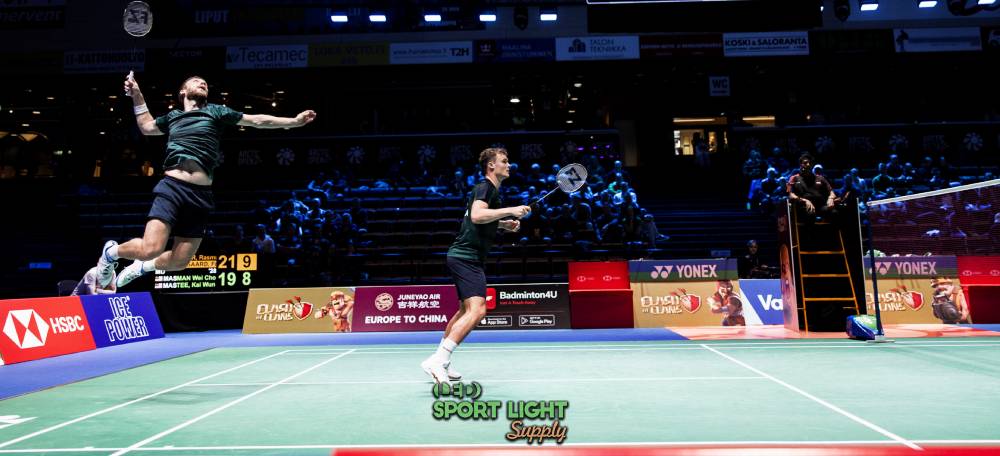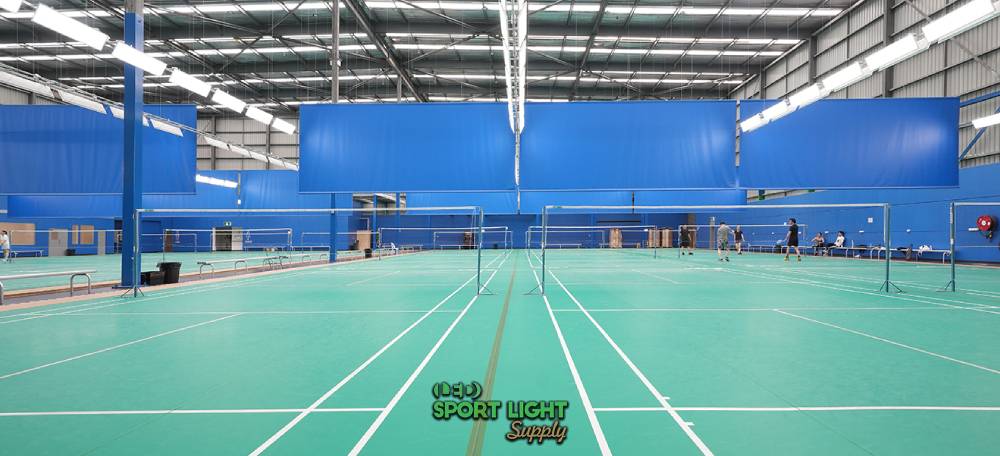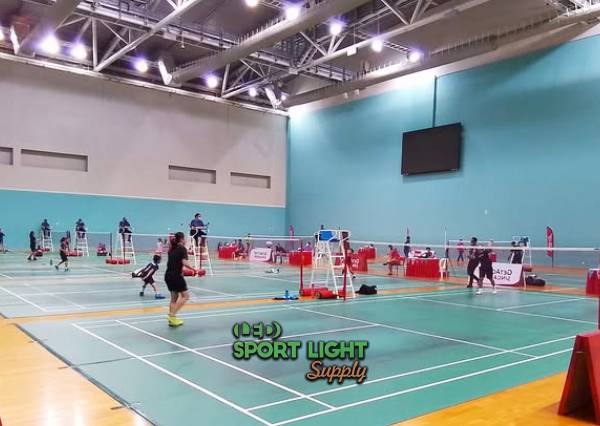Badminton, like any other indoor sport, requires well-designed lighting to ensure a fair and enjoyable playing environment. Proper lighting is not only about brightness but also about ensuring that players can see clearly without being hindered by glare. Glare, caused by direct or reflected light, can disrupt a player’s focus and even affect their performance. A well-lit badminton court can make a significant difference, providing players with the necessary visibility to compete at their best.
Table of Contents
ToggleUnderstanding Glare and Its Impact on Performance

What Is Glare?
Glare occurs when there is excessive brightness in a visual field, making it difficult for the eyes to adjust properly. This intense light creates discomfort by overpowering the surrounding environment, causing the eyes to struggle with contrast and clarity. Glare can come from various sources, including direct light fixtures, like overhead lights, or reflected light bouncing off surfaces such as floors, walls, and even the court itself. The scattered or overly bright light disrupts the normal visual process, resulting in a compromised ability to focus. On a badminton court, glare interferes with a player’s ability to track the fast-moving shuttlecock, leading to mistakes or missed shots. Furthermore, glare may create inconsistent lighting conditions across the court, exacerbating difficulties for players, especially when they are trying to quickly react to the shuttlecock’s unpredictable movements. As a result, players are distracted, and the overall experience of playing the game is hindered.
Effects of Glare on Badminton Players
In badminton, glare can have significant implications for a player’s ability to perform effectively. Since the shuttlecock moves rapidly and changes direction unexpectedly, any disruption in visual clarity can cause players to lose track of its path. This can lead to delayed or inaccurate reactions, causing errors in play. Prolonged exposure to glare can also cause visual fatigue, as the eyes are constantly straining to process information amidst high levels of brightness. This strain diminishes a player’s focus and alertness, impacting their overall performance. In some cases, intense glare can even result in eye strain or headaches, further decreasing a player’s stamina and making it harder for them to continue playing at their best. Glare, therefore, not only disrupts immediate gameplay but can also have long-term consequences if not addressed, affecting player comfort and performance throughout the duration of the game. Maintaining an optimal lighting setup is necessary to minimize glare and provide the best possible conditions for players to perform efficiently.
Designing Lighting to Reduce Glare

Choosing the Right Light Fixtures
The type of light fixtures chosen for a badminton court is one of the most influential factors in reducing glare. Traditional lighting systems, especially those with exposed bulbs or harsh reflectors, can direct intense beams of light toward players, creating direct glare. This can be particularly distracting during high-intensity gameplay when players need to maintain constant focus on the shuttlecock. To prevent this, it is essential to use high-quality, well-diffused light fixtures that are designed to distribute light evenly across the entire court. Fixtures that feature diffusers or lenses help scatter light more broadly, eliminating harsh shadows and preventing the light from being concentrated in one area. This not only minimizes the risk of glare but also enhances the overall visibility on the court. By using these types of fixtures, the lighting remains soft and uniform, reducing eye strain and creating a more comfortable playing environment for both recreational and professional players.
Strategic Placement of Lights
The arrangement and positioning of light fixtures are equally critical in controlling glare. Lights should be placed strategically to ensure that the court is evenly illuminated while minimizing the potential for direct light exposure to players’ eyes. Placing the light fixtures directly overhead in a grid pattern is one common method that ensures uniform light distribution across the entire playing area. This method helps avoid the creation of bright spots or dark patches that could interfere with a player’s vision. Additionally, careful consideration should be given to the height and angle of the fixtures. Positioning lights too low or too high can lead to uncomfortable glare that affects players’ line of sight. The optimal placement often involves mounting lights at an angle that directs the light toward the court while avoiding direct exposure to players’ line of sight. By angling the fixtures appropriately and ensuring their correct placement, glare can be minimized, and visibility can be maintained without compromising the quality of the lighting. This careful arrangement ensures that players have a clear and unobstructed view of the game, supporting a more engaging and fair experience.
Indirect Lighting: A Solution to Minimize Glare
What Is Indirect Lighting?
Indirect lighting is a lighting technique where light is directed away from the target area and reflected off surfaces such as ceilings, walls, or other reflective materials before reaching the playing field. Rather than shining directly onto the court, the light is bounced off surfaces to spread more evenly across the entire space. This approach eliminates the intense, direct beams that can cause discomfort and glare. By distributing the light across a larger area in a diffused manner, indirect lighting softens the intensity of illumination, reducing the creation of harsh shadows or overly bright spots. This softer light results in better overall visibility, as players are no longer subjected to sudden bursts of light that can momentarily impair their vision. The reflected light creates an even and consistent environment, which helps players focus on the game without straining their eyes. Indirect lighting also helps maintain the aesthetic quality of the space, as it is less intrusive compared to direct lighting sources.
Advantages of Indirect Lighting in Badminton Courts
 Indirect lighting offers numerous advantages in controlling glare and improving visibility in badminton courts. One of its most significant benefits is its ability to evenly diffuse light across the court. Since the light is reflected before reaching the playing surface, it reduces the chances of creating hot spots—areas with excessively bright light that can hinder a player’s vision. This even distribution of light ensures that all areas of the court are lit in a uniform manner, reducing the need for players to adjust their focus due to varying light intensities. Additionally, indirect lighting minimizes eye strain by offering a softer, more natural lighting experience. Players are no longer forced to squint or adjust their eyes to accommodate sudden changes in lighting conditions, which means they can maintain better focus throughout the game. This uniform illumination also helps to eliminate distractions caused by extreme contrasts in lighting, allowing players to remain fully engaged in their play. The reduced glare and enhanced visibility provided by indirect lighting ultimately contribute to a more enjoyable and performance-enhancing experience for players.
Indirect lighting offers numerous advantages in controlling glare and improving visibility in badminton courts. One of its most significant benefits is its ability to evenly diffuse light across the court. Since the light is reflected before reaching the playing surface, it reduces the chances of creating hot spots—areas with excessively bright light that can hinder a player’s vision. This even distribution of light ensures that all areas of the court are lit in a uniform manner, reducing the need for players to adjust their focus due to varying light intensities. Additionally, indirect lighting minimizes eye strain by offering a softer, more natural lighting experience. Players are no longer forced to squint or adjust their eyes to accommodate sudden changes in lighting conditions, which means they can maintain better focus throughout the game. This uniform illumination also helps to eliminate distractions caused by extreme contrasts in lighting, allowing players to remain fully engaged in their play. The reduced glare and enhanced visibility provided by indirect lighting ultimately contribute to a more enjoyable and performance-enhancing experience for players.
Implementing Indirect Lighting in Court Design
Successfully implementing indirect lighting in a badminton court requires thoughtful consideration of the court’s design and layout. To maximize the benefits of indirect lighting, the court’s surfaces must be able to reflect light efficiently. This involves using high-quality reflective materials in the ceiling and walls to ensure that light is effectively diffused before reaching the playing area. The ceiling, in particular, plays a significant role in this process, as it is often the primary surface from which light is reflected. A high gloss or light-colored ceiling can enhance the reflection of light, ensuring it is spread evenly throughout the court. Furthermore, the light fixtures themselves must be chosen carefully to suit the needs of indirect lighting. Fixtures that are designed to reflect light efficiently, such as recessed lights or wall-mounted fixtures, are ideal for this purpose. These fixtures direct light upward or along the walls, ensuring that it bounces off reflective surfaces without shining directly onto the court. Careful positioning of the light fixtures is also important; they must be placed at appropriate angles to ensure maximum light diffusion while avoiding direct exposure to the players’ eyes. By integrating these elements into the court design, indirect lighting can effectively minimize glare, improve visibility, and create an optimal environment for play.
Lighting Specifications for Badminton Courts
Illuminance Levels for Badminton Courts
Badminton courts require precise and well-planned levels of illumination to provide adequate visibility while also avoiding visual discomfort. According to international standards, the illuminance level for competitive badminton courts should fall within the range of 500 to 1000 lux. This level of brightness ensures that the shuttlecock can be clearly seen at all times, even during fast-paced movements. It also helps players judge distances and react quickly to sudden changes in the shuttle’s trajectory. However, it is crucial to strike a balance between brightness and comfort—while too little light can make the court difficult to navigate, excessive brightness can cause glare, which interferes with focus and visual clarity. Therefore, the lighting system should be adjusted to ensure there is enough illumination to clearly define the shuttlecock and other court markings without overwhelming the eyes. A well-balanced illuminance level promotes a more comfortable playing experience, reducing the likelihood of visual fatigue and distractions caused by glaring light sources.
Color Temperature and its Role in Visibility
The color temperature of the lighting on a badminton court plays a critical role in enhancing visibility and creating a suitable environment for play. Color temperature, measured in Kelvins (K), determines the warmth or coolness of the light emitted. For badminton courts, lights with a color temperature between 4000K and 5000K are typically recommended. This range produces a neutral to cool white light that is bright enough to improve contrast, making it easier for players to see the shuttlecock against the backdrop of the court. Cooler color temperatures, around 5000K, are particularly effective in sports environments because they help to increase alertness and concentration. This type of light promotes better focus by minimizing visual distractions, allowing players to concentrate fully on their performance. Additionally, cooler lights reduce the yellowish hue that warmer lights may produce, providing better color rendition and ensuring that the players’ movements are more visible. Using the correct color temperature ensures that the court remains illuminated in a way that maximizes clarity and promotes optimal gameplay conditions.
Uniformity of Lighting
Uniformity in lighting is a key element in reducing glare and ensuring that all areas of the badminton court are evenly lit. Uneven lighting creates variations in brightness across the court, leading to bright spots or shadows that can distract players and interfere with their ability to track the shuttlecock. The goal of a well-designed lighting system is to provide an even distribution of light across the entire playing area, ensuring that no part of the court is under-illuminated or overly bright. Achieving uniformity requires careful calculation of light fixture placement, height, and angle to ensure that the light is spread evenly across the surface. In addition to the placement of fixtures, the use of diffusers or lenses can help to further soften and spread light, contributing to a more balanced illumination. A uniform lighting setup not only helps reduce glare but also enhances players’ ability to maintain focus and play consistently throughout the game. By ensuring the court is evenly lit from all angles, players can enjoy a more comfortable and visually coherent environment, which is essential for peak performance.
Technological Innovations in Court Lighting
LED Lighting Systems
LED lighting has become the standard for modern sports facilities due to its energy efficiency and ability to deliver high-quality, consistent illumination. LEDs provide uniform light distribution and can be dimmed or adjusted to meet specific needs. They also produce less heat than traditional lighting, which helps to maintain a comfortable playing environment.
Smart Lighting Control Systems
Smart lighting systems allow for real-time adjustments to lighting conditions based on the needs of the game. These systems can adjust brightness levels dynamically, ensuring that the court remains well-lit without creating glare. By incorporating sensors and control technologies, smart lighting can optimize both the energy efficiency and quality of the lighting in badminton courts.
Maintaining the Lighting System for Optimal Performance
Regular Maintenance and Cleaning
Over time, dust and dirt can accumulate on lighting fixtures, reducing their effectiveness and potentially causing glare. Regular cleaning of lights and fixtures is essential to ensure they maintain their brightness and clarity. This helps to avoid the accumulation of shadows or bright spots, which can interfere with gameplay.
Monitoring and Replacing Bulbs
Lights can lose their brightness over time, leading to uneven illumination. Monitoring the performance of lighting systems and replacing bulbs as needed ensures that the court remains consistently well-lit. It’s also important to check for any flickering lights, as this can cause distractions and affect the players’ focus.
Conclusion
The combination of proper light fixture selection, strategic placement, and the use of indirect lighting techniques is the key to minimizing glare and improving visibility in badminton courts. By ensuring an even distribution of light and addressing the specific needs of the game, players can enjoy a more comfortable and competitive environment. The adoption of modern lighting technologies, such as LED systems and smart controls, further enhances the performance of court lighting, making it possible to create the perfect conditions for both recreational and competitive play. Proper maintenance of lighting systems also ensures that these optimal conditions are sustained over time. With thoughtful consideration of all these factors, glare can be minimized, and visibility can be maximized, allowing players to perform at their best.
